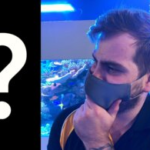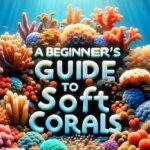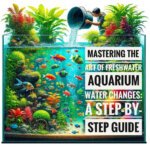Sea Pens: The Feather-like Filter Feeders
Reef aquariums offer a fascinating glimpse into the diverse and intricate world of marine life. Among the myriad of unique and captivating creatures that can inhabit a reef tank, sea pens stand out due to their delicate, feather-like appearance and intriguing behaviours. This comprehensive guide will explore the fascinating world of sea pens, their feeding habits, and how to successfully incorporate them into a reef aquarium.
What Are Sea Pens?
Sea pens are colonial marine cnidarians belonging to the order Pennatulacea. They are closely related to corals and sea anemones. Named for their resemblance to old-fashioned quill pens, sea pens consist of a central stalk with numerous polyps branching out from it, creating a feathery appearance. Each polyp has a specific role, contributing to the overall function and survival of the colony.
Types of Sea Pens
Sea pens come in various shapes, sizes, and colours. Here are some of the most commonly encountered types in reef environments:
1. Plume Sea Pens (Virgularia spp.)
• Appearance: Long, slender stalks with feathery plumes extending outward.
• Colour: Typically white, cream, or pale yellow.
• Habitat: Found in sandy or muddy substrates where they can anchor themselves.
2. Sea Swords (Ptilosarcus gurneyi)
• Appearance: Thick central stalk with broad, flattened branches resembling a sword.
• Colour: Often orange or reddish-brown.
• Habitat: Commonly found in deeper waters with softer substrates.
3. Quill Pens (Pennatula phosphorea)
• Appearance: Sturdy central stalk with delicate, feather-like branches.
• Colour: Varies from white to pink or red.
• Habitat: Prefers calm, sandy environments where they can bury their base.
4. Sea Feathers (Cavernularia obesa)
• Appearance: Shorter, more compact colonies with dense, feathery branches.
• Colour: Generally shades of yellow or brown.
• Habitat: Found in shallow, protected areas with sandy or muddy bottoms.
Feeding Habits of Sea Pens
Sea pens are filter feeders, relying on water currents to bring plankton and other small organic particles to their polyps. Each polyp is equipped with tentacles that capture food particles from the surrounding water. Here are some key aspects of their feeding habits:
1. Planktonic Diet
• Sea pens primarily feed on plankton, including phytoplankton and zooplankton. They extend their polyps into the water column to capture these microscopic organisms.
2. Nocturnal Feeding
• Many sea pens are nocturnal feeders, extending their polyps at night when plankton is more abundant in the water column. This behaviour helps them avoid predation during the day.
3. Symbiotic Relationships
• Some sea pens have symbiotic relationships with specific species of shrimp or fish that help keep their surface clean and free from debris, improving their feeding efficiency.
Incorporating Sea Pens into a Reef Tank
Successfully keeping sea pens in a reef aquarium requires careful attention to their specific needs and environmental conditions.
Tank Setup and Environment
1. Tank Size
• A minimum tank size of 30 gallons is recommended to provide ample space and stable water conditions. Larger tanks are preferable to accommodate multiple sea pens and ensure adequate water flow.
2. Substrate
• Sea pens require a soft, sandy, or muddy substrate in which they can anchor themselves. Ensure the substrate is deep enough (at least 3-4 inches) to allow for proper burrowing and stability.
3. Water Parameters
• Maintain stable water conditions with temperatures between 72-78°F, salinity levels of 1.023-1.025 specific gravity, and a pH of 8.1-8.4. Regular water changes and monitoring of nitrate and phosphate levels are crucial to prevent the buildup of waste that can harm sea pens.
4. Lighting
• Low to moderate lighting is usually sufficient for sea pens. Excessive light can promote algae growth on their surfaces, which can be detrimental. Consider placing sea pens in shaded areas of the tank or using adjustable lighting to create suitable conditions.
5. Water Flow
• Provide moderate, gentle water flow to ensure a steady supply of plankton and other food particles. Avoid strong currents that could dislodge or damage the sea pens.
Feeding and Nutrition
1. Plankton Supplements
• In addition to natural plankton in the water, supplement their diet with commercially available phytoplankton and zooplankton products. These can be added directly to the tank water to enhance their food supply.
2. Target Feeding
• If necessary, use a pipette or turkey baster to target feed the sea pens, delivering planktonic food directly to their polyps. This can help ensure they receive adequate nutrition, especially in tanks with low natural plankton levels.
Compatibility with Other Tank Inhabitants
1. Fish
• Sea pens are generally compatible with a variety of reef-safe fish. Avoid housing them with aggressive or predatory fish that may nip at their polyps or disturb their substrate.
2. Invertebrates
• Most reef-safe invertebrates, such as cleaner shrimp, snails, and hermit crabs, can coexist peacefully with sea pens. Be cautious with burrowing or digging invertebrates that may disrupt their anchoring.
3. Corals
• Sea pens can be placed near or among corals, provided there is sufficient space for both to thrive without competing for resources. Ensure that water flow and lighting conditions are suitable for both sea pens and corals.
Challenges and Considerations
While sea pens offer numerous benefits, they also come with several challenges and considerations for aquarists:
1. Sensitivity to Water Quality
• Sea pens are sensitive to changes in water quality. Poor water conditions can cause stress and lead to health issues. Regular water changes, efficient filtration, and careful monitoring of water parameters are essential to prevent the buildup of harmful substances.
2. Substrate Requirements
• Providing an appropriate substrate is crucial for the health and stability of sea pens. Ensure the substrate is deep and soft enough for proper anchoring and burrowing.
3. Feeding Needs
• Sea pens require a steady supply of plankton and other food particles to thrive. Ensure that their dietary needs are met through natural plankton in the water or supplemental feeding.
4. Predation
• Some marine species, including certain fish and invertebrates, may prey on sea pens. Research the compatibility of tank inhabitants to prevent predation and ensure the safety of your sea pens.
Popular Sea Pens for Reef Aquariums
1. Orange Sea Pen (Ptilosarcus gurneyi)
• Colour: Bright orange
• Description: Known for its sword-like structure and vibrant colour, the orange sea pen adds a striking visual element to reef tanks.
2. Red Quill Pen (Pennatula rubra)
• Colour: Red or pink
• Description: This sea pen has a delicate, feather-like appearance and vibrant coloration, making it a beautiful addition to any aquarium.
3. Yellow Sea Feather (Cavernularia obesa)
• Colour: Yellow or brown
• Description: Known for its short, compact colonies and feathery branches, the yellow sea feather is both beautiful and functional as a filter feeder.
Conclusion
Sea pens are truly remarkable filter feeders that offer a wealth of benefits to reef aquariums. Their delicate, feather-like structures, vibrant colours, and exceptional filtration capabilities make them a valuable addition to any marine tank.
By understanding their unique needs and providing the appropriate care, you can enjoy the beauty and functionality of these fascinating organisms. Whether you’re a seasoned aquarist or new to the reef-keeping world, incorporating sea pens into your aquarium can enhance the health, biodiversity, and aesthetic appeal of your reef ecosystem.








